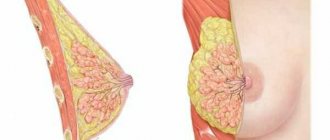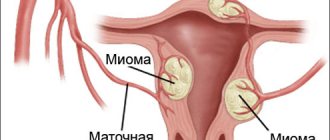Da!Zachatie
Website about pregnancy, from planning to birth
Popular
TSH when planning pregnancy: what is the norm for successful conception?
Home › Preparing for conception
What is the level of fertility in women, how can you find out your ovarian reserve, which affects the ability to get pregnant? Fertility is a term that refers to the ability of an adult of reproductive age to reproduce and applies to both women and men. In women, reproductive capabilities depend on various factors and with age, due to physiological characteristics, the ability to conceive decreases.
- 1 About the concept of fertility
- 2 Reproductive period
- 3 How is fertility determined in women? 3.1 Ovarian reserve on ultrasound
- 3.2 Anti-Mullerian hormone and its meanings
Fertility - what is it?
The term “fertility” is of Latin origin: “fertilis” - “fertile”. This concept is the opposite of infertility.
Fertility is the ability to reproduce healthy offspring. Applies to both male and female genders. But most often it is used to describe a girl’s reproductive potential.
Some people can easily get pregnant on the first try, while others need to try for a long time. And sometimes you can get pregnant only after going to a clinic for artificial insemination.
Fertility in men is the ability to impregnate a woman, and for a woman to conceive and give birth to a healthy child.
The reproductive period for a girl begins with the appearance of the menstrual cycle, and for guys - with the production of live and active sperm.
There are cases where it was possible to get pregnant at a fairly late period. For example, a woman from the island of Guernsey gave birth at 59 years old. She was helped to conceive using hormone therapy. But a resident of Russia herself carried a girl, who was born when her mother was 57 years old.
An Indian woman at the age of 70 was able to give birth to twins. The youngest mother is considered to be a girl in Peru. Due to the fact that her body developed very quickly, she was able to give birth at only 5 years old! Doctors helped her through a caesarean section.
All of these examples are exceptions to the rule. For the most part, there are 4 conventional stages of fertility:
- Early. From the beginning of the first menstruation to 20 years. During this period, the girl’s cycle and the production of sex hormones begin to normalize. The chance of conceiving is very high.
- Average. Until the age of 40, the cycle is stable and there are no health problems that can begin later with age. It is considered the best period for pregnancy.
- Late. Until the age of 45, hormones are released unevenly, but ovulation is usually stable. Conception occurs naturally. You only need the help of medical personnel to give birth.
- Stage of fading reproduction. Before the age of 60, menopause begins - the cycle becomes irregular, and then stops altogether. Pregnancy without the help of doctors is impossible.
Late reproductive age
Psychologists and gynecologists have different attitudes towards childbirth in the period after 35 years before the onset of menopause. Psychologists believe that at this stage of life a woman consciously wants a child and understands all the difficulties and joys of caring for him. For this, the material basis has already been prepared and life experience has been accumulated. A mature woman who is planning a pregnancy is attentive to her health and disciplinedly follows doctors’ recommendations.
Gynecologists have a different opinion: the first pregnancy after 35 years can be difficult and dangerous to health. As a result of a large number of cycles in which ovulation occurred without fertilization, the uterus may not accept a fertilized egg. This, as well as chronic diseases, complicates conception. This subsequently leads to problems during pregnancy and childbirth. In particular this could be:
- premature, post-term pregnancy;
- gestosis - a persistent increase in blood pressure, extremely dangerous for mother and child;
- hypoxia - insufficient oxygen supply to the fetus;
- premature rupture of amniotic fluid;
- uterine bleeding;
- miscarriage;
- chromosomal abnormalities in fetal development (the risk of Down syndrome increases significantly after 35 years);
- gestational diabetes mellitus;
- placenta previa and premature placental abruption;
- increased risk of breast and brain cancer.
Modern diagnostic methods can detect abnormalities in fetal development in the early stages of pregnancy. In some cases, the doctor may administer the treatment in utero. In older women in labor, labor is more often complicated, which leads to the need for a cesarean section.
Late motherhood, in addition to possible difficulties, has positive aspects. Hormonal changes rejuvenate the body, giving strength and energy for care and education. The desire to raise and raise a child increases life expectancy, and later menopause occurs.
Reproductive age ends when eggs stop maturing and menstruation ends completely. Natural conception becomes impossible. A new physiological stage begins.
Pregnancy at 40
Until the age of 30, a healthy woman can become pregnant with a probability of up to 20%. From 30 to 40 years of age this possibility drops to 5%. If difficulties arise, special clinics can help. For example, during menopause, medical procedures increase the percentage to 30%.
Today there is a tendency towards conscious late pregnancy. Since female representatives want to realize themselves in a career, both the need for personal development and from the point of view of capital accumulation, in order to create good conditions for raising a child.
Opinions differ on this matter. Some believe that it is better to give birth before the age of 35, so that there are no exacerbations of chronic diseases that negatively affect the bearing of the fetus: the risk of miscarriage, toxicosis.
Others say it wakes up the body. The production of hormones by the ovaries and thyroid gland is activated, and energy appears.
Success in your career, reliable financial status and life experience allow you to worry significantly less, which has a positive effect on pregnancy. And modern medical technologies will make it possible to avoid fetal developmental disorders.
Smoking
Smoking affects all stages of the reproductive cycle, affecting the formation and maturation of the egg, hormone production, embryo development, and the condition of the uterus.
During pregnancy, smoking increases the risk of complications, low birth weight, stillbirth, and ectopic pregnancy.
Smokers experience menopause two years earlier than those who do not smoke.
Male Fertility Index
To determine a man's reproductive capacity, the semen must be submitted for laboratory testing.
There they will take a spermogram to study the quality and quantity of sperm, motility and shape. After this, the fertility index is calculated.
- Farris index. To calculate it, you need to take 1 ml of sperm. And count the number of motile sperm. Normally, the indicator should be within 20–25. Below, fertility is low; if above, fertility is increased.
- Kruger index. I estimate the size of the tail, head and neck. I calculate the ratio of healthy sperm to defective ones. 30% is the norm, lower – reproduction suffers, higher – good sperm quality.
Spermogram results show the quality and quantity of healthy sperm. Since it is easier for a man to get tested, he is the first of the couple to be examined to rule out a problem on his part.
What affects male fertility?
With age, the production of the male hormone testosterone decreases. This directly affects potency and reproductive function.
Although fertility lasts until approximately age 80, over time it becomes difficult to conceive.
Factors that affect the ability to conceive a child:
- chronic stress;
- genital injuries;
- increased body temperature (directly, the testicles, since the process of sperm production is disrupted);
- low amount of fluid in the body;
- acute infectious diseases of the genitourinary system;
- arterial hypertension;
- diabetes;
- smoking and excessive drinking;
- overweight.
Puberty in men
A teenager reaches puberty at the age of 14-15 years. But in the future, an alternation of certain periods occurs in the male body, affecting sexual life and reproductive abilities in particular.
From about 10-12 years of age, boys begin to experience physiological changes leading to puberty. Sexual feelings and thoughts become more and more noticeable. Conventionally, the process can be divided into three stages:
- Showing interest in the opposite sex.
- Desire for physical contact in the form of touching, holding hands, kissing.
- The emergence of sexual desire.
In the early stages of growing up, boys simply become friends with girls, then an attraction to touching and mutual caresses arises, which leads to erotic fantasies and a strong desire for sexual intimacy. After feeling his sexuality, a young man becomes more interested in the physiology of relationships; for most girls, feelings are more important in this regard.
On the way to puberty, testosterone levels in the body increase. This main male sex hormone contributes to the development of basic sexual characteristics in adolescents, making them both fertile and attractive to the opposite sex.
A teenager’s decision to have sexual intercourse for the first time depends on his upbringing and his social circle. The first sexual contact sometimes occurs under the influence of social stereotypes about male sexuality. This can lead to promiscuous sexual relations according to the established scheme “the goal is sex.” Emotional correspondence with a partner is not given much importance.
Subsequent growth in most guys creates a need for more sensual and long-term relationships, and a desire to start a family appears. Other young people prefer to remain free both in life and in sexual relationships.
Many men claim that only after reaching adulthood did they experience true pleasure from having sex with their beloved wife. Moreover, the partners are already aware of each other’s sensual subtleties. Physical satisfaction takes on a more emotional coloring.
How to determine the level of female reproduction?
Female fertility is divided into three stages - this is the ability to:
- conceive a child;
- take out;
- give birth.
A normal level of reproduction is the ability to go through all stages without medical intervention. Low – there is a problem on one or more points. High – ability to become pregnant within a short period of time.
For diagnosis, a woman undergoes an ultrasound scan of the ovaries on days 5-6 of the menstrual cycle. The doctor looks at the number of follicles that are in the growth phase. It also evaluates their size, the ratio of connective and hormonal tissue. After such a study, points are given. -2 to +2: low and high level respectively.
Another type of study is hormonal. The level of follicle-stimulating and luteinizing biologically active substances is determined. The amount of the first should not exceed the amount of the second.
There are also home fertility tests that work in a similar way to detect pregnancy. You need to dip the test strip into the urine. The result does not show the overall reproductive capacity of a woman, but directly at the moment.
Even if it is low now, you should not give up on yourself, but you need to go to the clinic for a detailed professional examination.
Possible complications
If within 2 years of regular sexual activity it was not possible to conceive a child, the couple is diagnosed with infertility. The sooner treatment is started, the greater the likelihood of solving the problem.
Also, inaction during low fertility can lead to advanced forms of the diseases that caused this phenomenon.
Medical science has developed many methods to help you get pregnant. Therefore, if you cannot conceive a child, you should not think that low fertility is forever. Having discovered a problem in a woman’s reproductive system, the doctor will give recommendations on how to solve it.
Author: Pronina Marina
Article design: Oleg Lozinsky
Negative factors of female fertility disorders
Factors that influence the occurrence of reproductive disorders in a woman:
- overweight or too underweight;
- early menopause;
- chronic stress;
- diabetes mellitus and thyroid dysfunction;
- obstruction of the fallopian tubes;
- polycystic ovary syndrome;
- adhesions in the pelvis;
- abortions and other surgical interventions in the genital organs;
- a disorder in the immune system that contributes to sperm rejection;
- long-term use of medications (non-steroidal anti-inflammatory drugs, steroids, thyroid hormones, antidepressants and antipsychotics).
The absence of these aspects does not guarantee normal fertility. It is important for a woman to eat right, avoid heavy physical activity, get enough rest, and live in peace without frequent stress and anxiety.
Fertility window
If both partners have a high reproductive rate, this does not mean that they will be able to conceive a child the first time.
There is such a thing as the fertile window, and it must be taken into account. This is 5 days before the start of ovulation and directly during the most favorable period.
Ovulation occurs approximately halfway through the monthly cycle. If we consider that in women it lasts about 28 days, then this will be on the 14th day. But since each organism is individual, the girl must determine this time herself.
Some women look at their sensations: abdominal pain, cramps, breast and areola enlargement, increased libido. Others notice a change in their daily discharge: becoming sticky and sticky.
There are ways to more accurately determine the fertile window:
- Temperature method. Every morning for 1-2 months you need to measure your rectal temperature immediately after waking up before getting out of bed. After this, mark the indicators in the graph. During ovulation, the figure is 0.2-0.6 ºС higher.
- Calendar. This observation lasts up to six months. It is necessary to mark the beginning and end of menstruation. After this you can find the middle. The accuracy of the method is up to 50%.
- Ovulation test strip is the most effective method mentioned above.
Treatments and Alternatives
There are two types of assisted reproductive technology:
- superovulation with intrauterine insemination (IUI);
- in vitro fertilization (IVF).
IUI uses medications that increase the number of eggs. When they are ready to ovulate, the sperm is placed directly into the woman's body.
During IVF, an egg is collected and fertilized in the laboratory (either the sperm of a partner or a donor can be used). The embryo is then placed in the uterus.
If a woman has ovarian depletion due to age, egg donation is used. A client who wants to become pregnant is taking hormone therapy. After this, the embryo is placed in the uterus, just as with IVF.









